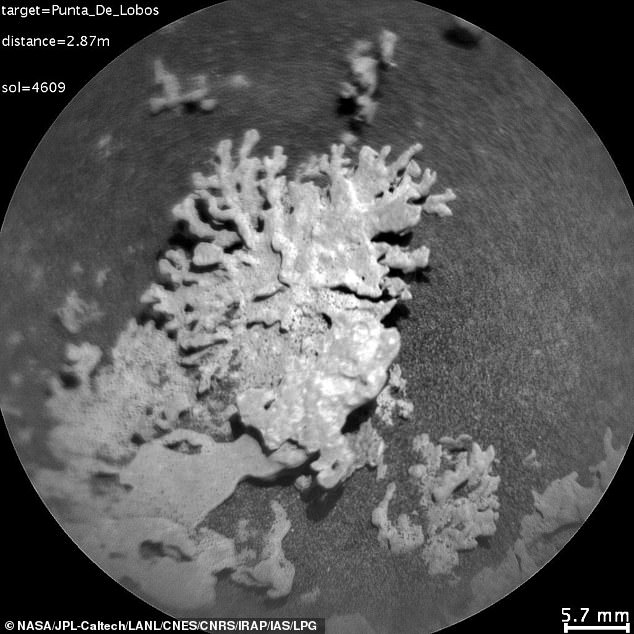By STACY LIBERATORE, U.S. SCIENCE & TECHNOLOGY EDITOR
NASA‘s Curiosity rover snapped a bizarre, coral-shaped rock on the surface of Mars, sparking fresh speculation about signs of ancient life on the Red Planet.
The twisted, alien-like formation was sculpted by wind and time, according to NASA, which said it likely formed billions of years ago when water once flowed across the Martian surface.
The images have taken the internet by storm, with some users claiming: ‘Corals are true signs of ancient life forms along with the ancient rivers. This is a huge discovery!!’
Another wrote on X: ‘There’s your Mars fossilized foreign life material evidence everybody’s been asking for. That’s obviously been there all along.’
Scientists said mineral-rich water once seeped into tiny cracks in Martian rocks, depositing solid veins that were later exposed by billions of years of wind erosion.
‘Curiosity has found many small features like this one, which formed billions of years ago when liquid water still existed on Mars,’ NASA shared.
‘Water carried dissolved minerals into rock cracks and later dried, leaving the hardened minerals behind.’
Billions of years of wind-driven erosion gradually stripped away the surrounding rock, revealing the unusual shapes visible today, the space agency added.

NASA’s Curiosity rover has beamed back a stunning image of a coral-shaped rock on Mars

The image has sparked fresh speculation of life on Mars, but scientists said mineral-rich water once seeped into tiny cracks in Martian rocks, depositing solid veins that were later exposed by billions of years of wind erosion
The strange formation was captured on July 24, 2025, Curiosity’s 4,609th Martian day, by the rover’s Remote Micro Imager, part of its ChemCam instrument.
The seven-foot-long wheeled robot is currently exploring Gale Crater, a region rich in boxwork formations, networks of ridges that were likely formed by ancient groundwater.
These formations are helping scientists understand how the Martian environment transformed from a potentially habitable place to the desert it is today.
Mars is a frozen desert with water largely as ice, but the coral‑like rock serves as a reminder that the planet once hosted liquid water on its surface, shaping its geology.
While claims of life on Mars are flooding the web, others on X marveled at the discovery, as ‘further implying that Mars had water early in its existence.’
Curiosity has in the past discovered a diverse assortment of similar small features that formed when mineralizing fluids traveled through conduits in the rock.
The rover stumbled upon a flower-like rock in 2022, which was also made in the ancient past when minerals carried by water cemented the rock.
But the discoveries have raised the idea that the Red Planet may have supported life at some point due to its once flowing with water.

However, this does support the idea that Mars was once flowing with water

The rover stumbled upon a flower-like rock in 2022, which was also made in the ancient past when minerals carried by water cemented the rock
In 2024, NASA announced that its Perseverance rover had discovered the first ‘possible’ signs of ancient life on the Red Planet.
The agency’s Perseverance rover spotted what they described as an arrowhead-shaped’ rock with what looked like veins flowing through it.
The rover beamed the images back to Earth, revealing crystalline solids left over from water flowing on the surface and a reddish area that contained organic compounds and an energy source for ‘what could have been microbial life.’
The rock, which measures 3.2 feet by two feet, has been named after a Grand Canyon waterfall, Cheyava Falls.
Scientists determined it featured chemical signatures and structures formed by microbial life billions of years ago.
Ken Farley, Perseverance project scientist, said: ‘Cheyava Falls is the most puzzling, complex, and potentially important rock yet investigated by Perseverance.
‘On the one hand, we have our first compelling detection of organic material, distinctive colorful spots indicative of chemical reactions that microbial life could use as an energy source, and clear evidence that water — necessary for life — once passed through the rock.
‘On the other hand, we have been unable to determine exactly how the rock formed and to what extent nearby rocks may have heated Cheyava Falls and contributed to these features.’
Perseverance collected the rock on July 21 while exploring the northern edge of Neretva Vallis, an ancient river valley carved by water rushing into Jezero Crater, a lake 3.7 billion years ago.

In 2024, Perseverance spotted a vein-filled arrowhead-shaped rock that featured chemical signatures and structures formed by microbial life billions of years ago. The leopard spots may be signs of ancient life
The team noticed the vein-like structures throughout, finding they were white calcium sulfate.
The crystalline solids on the Martian surface are hard-water deposits left behind by ancient groundwater flowing through the now dusty landscape.
Between those veins were bands of material with a reddish color, suggesting the presence of hematite, one of the minerals that gives Mars its distinctive rusty hue.
A deeper look at the reddish region revealed ‘dozens of irregularly shaped, millimeter-size off-white splotches, each ringed with black material, akin to leopard spots,’ shared NASA.
Perseverance used an X-ray tool to analyze the spots, determining that the black halos contained iron and phosphate.
David Flannery, an astrobiologist and member of the Perseverance science team, said: ‘These spots are a big surprise.
‘On Earth, these types of features in rocks are often associated with the fossilized record of microbes living in the subsurface.’
This article was originally published by a www.dailymail.co.uk . Read the Original article here. .

